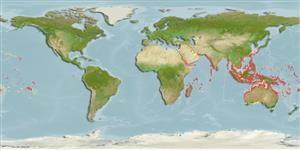Environment: milieu / climate zone / distribuzione batimetrica / distribution range
Ecologia
marino; salmastro associati a barriera corallina; distribuzione batimetrica 0 - 30 m (Ref. 128797). Tropical; 22°C - 28°C; 32°N - 35°S, 20°E - 130°W
Indo-Pacific: Red Sea and East Africa and Persian Gulf (Ref. 68964) to the Tuamoto Islands, north to southern Japan, south to northern Australia and New Caledonia. Recorded off the coast of Florida in the Western Central Atlantic (Ref. 51238).
Size / Peso / Age
Maturità: Lm ? range ? - ? cm
Max length : 60.0 cm TL maschio/sesso non determinato; (Ref. 5450)
Spine dorsali (totale) : 5; Raggi dorsali molli (totale) : 34 - 39; Spine anali: 3; Raggi anali molli: 25 - 29. The ocular band of adult specimens with a series of dark vermiculations (Ref. 1602). Adults (above 20 cm) yellowish silvery or dusky, dark bar through eye and another bar just behind head. Occasionally with a few small, scattered black spots on body. Median fins yellowish, with black margins posteriorly. Pelvic fins black. Small juveniles reddish brown, with irregular black spots and blotches and small, white (black-edged) ocelli on body. Small black spot at base of last 3 dorsal- and anal-fin rays. Caudal fin transparent except for base, which is reddish brown. Body orbicular and strongly compressed, its depth more than twice length of head and 0.9 to 1.4 times SL. Head length 3.4 to 3.8 times SL. Snout profile of large adults (above 40 cm total length) concave, with bony swelling between eyes. Interorbital width 38 to 48% head length. Jaws with bands of slender, flattened, tricuspid teeth, the middle cusp about twice length of lateral cusps. No teeth on palatines or vomer. Five pores on each side of lower jaw. Preopercle smooth. Opercle without spines (Ref 43039).
Body shape (shape guide): short and / or deep; Cross section: compressed.
Live in shallow protected coastal waters to deep, somewhat silty habitats. Often with deep shipwrecks (Ref. 48637). Adults are found singly or in small groups and occasionally in large schools in some areas. Juveniles occur singly or in small groups among mangroves and inner sheltered lagoons while adults move out to open waters over sandy areas of deep lagoons, channels, and seaward reefs to a depth of at least 30 m. Feed on algae, invertebrates and small fishes (Ref. 89972).
Life cycle and mating behavior
Maturità | Riproduzione | Deposizione | Uova | Fecundity | Larve
Myers, R.F., 1991. Micronesian reef fishes. Second Ed. Coral Graphics, Barrigada, Guam. 298 p. (Ref. 1602)
IUCN Red List Status (Ref. 130435: Version 2025-1)
Threat to humans
Harmless
Human uses
Pesca: scarso interesse commerciale; Acquacoltura: commerciale; Acquario: Commerciale
Strumenti
Special reports
Download XML
Fonti Internet
Estimates based on models
Preferred temperature (Fonte Biblio.
123201): 24.9 - 29.2, mean 28.5 °C (based on 3165 cells).
Phylogenetic diversity index (Fonte Biblio.
82804): PD
50 = 0.5313 [Uniqueness, from 0.5 = low to 2.0 = high].
Bayesian length-weight: a=0.03236 (0.01637 - 0.06397), b=2.96 (2.78 - 3.14), in cm total length, based on LWR estimates for this species & (Sub)family-body (Ref.
93245).
Trophic level (Fonte Biblio.
69278): 3.3 ±0.49 se; based on food items.
Resilienza (Fonte Biblio.
120179): Medio, tempo minimo di raddoppiamento della popolazione 1.4 - 4.4 anni (Preliminary K or Fecundity.).
Fishing Vulnerability (Ref.
59153): Moderate vulnerability (44 of 100).
🛈
Nutrients (Ref.
124155): Calcium = 35.1 [18.3, 56.0] mg/100g; Iron = 0.48 [0.30, 0.77] mg/100g; Protein = 19 [18, 20] %; Omega3 = 0.0993 [, ] g/100g; Selenium = 32.3 [18.4, 59.2] μg/100g; VitaminA = 41.7 [11.6, 145.4] μg/100g; Zinc = 1.13 [0.79, 1.61] mg/100g (wet weight);
